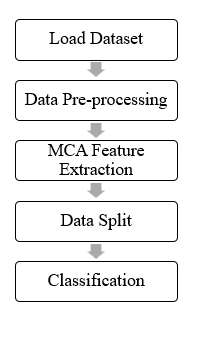Mitigation of Attacks via Improved Network Security in IoT Network using Machine Learning
Main Article Content
Abstract
In this paper, we develop a support vector machine (SVM) based attack mitigation technique from the IoT network. The SVM aims to classify the features related to the attacks based on pre-processed and feature extracted information. The simulation is conducted in terms of accuracy, precision, recall and f-measure over KDD datasets. The results show that the proposed SVM classifier obtains high grade of classification accuracy in both training and testing datasets.
Article Details
References
A. Mpatziakas, A. Drosou, S. Papadopoulos, and D. Tzovaras, “IoT threat mitigation engine empowered by artificial intelligence multi-objective optimization.” Journal of Network and Computer Applications, vol.203, pp.103398. 2022.
O. D. Okey, S. S. Maidin, P. Adasme, R. Lopes Rosa, M. Saadi, D. Carrillo Melgarejo, and D. Zegarra Rodríguez, BoostedEnML: “Efficient Technique for Detecting Cyberattacks in IoT Systems Using Boosted Ensemble Machine Learning”. Sensors, vol.22, no.19, pp.7409. 2022.
N. Mahajan, A. Chauhan, H. Kumar, S. Kaushal, and A.K. Sangaiah, “A Deep Learning Approach to Detection and Mitigation of Distributed Denial of Service Attacks in High Availability Intelligent Transport Systems”. Mobile Networks and Applications, pp.1-21. 2022.
V. Ravi, R. Chaganti, and M.Alazab, “Recurrent deep learning-based feature fusion ensemble meta-classifier approach for intelligent network intrusion detection system.” Computers and Electrical Engineering, vol.102, pp.108156. 2022.
Asim, A. ., & Cada, M. . (2023). Enhancement of Physical Layer Security in Flying Ad-hoc Networks by Intelligent Reflecting Metasurfaces. International Journal of Intelligent Systems and Applications in Engineering, 11(1s), 46–50. Retrieved from https://ijisae.org/index.php/IJISAE/article/view/2475
M. Ghiasi, T. Niknam, Z. Wang, M. Mehrandezh, M. Dehghani, and N. Ghadimi, “A comprehensive review of cyber-attacks and defense mechanisms for improving security in smart grid energy systems”: Past, present and future. Electric Power Systems Research, vol.215, pp.108975. 2023.
Mr. Dharmesh Dhabliya, Mr. Rahul Sharma. (2012). Efficient Cluster Formation Protocol in WSN. International Journal of New Practices in Management and Engineering, 1(03), 08 - 17. Retrieved from http://ijnpme.org/index.php/IJNPME/article/view/7
B. B. Behera, R. K. Mohanty, and B. K. Pattanayak, Attack Detection and Mitigation in Industrial IoT: “An Optimized Ensemble Approach”. Specialusis Ugdymas, vol.1, no.43, pp.879-905. 2022.
Z. Abou El Houda, B. Brik, and L. Khoukhi, “Why Should I Trust Your IDS?”: “An Explainable Deep Learning Framework for Intrusion Detection Systems in Internet of Things Networks”. IEEE Open Journal of the Communications Society, vol.3, pp.1164-1176. 2022.
R. Amrish, K. Bavapriyan, V. Gopinaath, A. Jawahar, and C. V. Kumar, “DDoS Detection using Machine Learning Techniques”. Journal of IoT in Social, Mobile, Analytics, and Cloud, vol.4, no.1, pp.24-32. 2022.
Rodriguez, L., Rodríguez, D., Martinez, J., Perez, A., & Ólafur, J. Leveraging Machine Learning for Adaptive Learning Systems in Engineering Education. Kuwait Journal of Machine Learning, 1(1). Retrieved from http://kuwaitjournals.com/index.php/kjml/article/view/103
T. Saba, A. Rehman, T. Sadad, H. Kolivand, and S. A. Bahaj, “Anomaly-based intrusion detection system for IoT networks through deep learning model”. Computers and Electrical Engineering, vol.99, pp.107810. 2022.
T. Berghout, M. Benbouzid, and S. M. Muyeen, “Machine learning for cybersecurity in smart grids: A comprehensive review-based study on methods, solutions, and prospects”. International Journal of Critical Infrastructure Protection, pp.100547. 2022
U. Islam, A. Muhammad, R. Mansoor,M. S. Hossain, I. Ahmad, E. T. Eldin, and M.Shafiq, “Detection of distributed denial of service (DDoS) attacks in IOT based monitoring system of banking sector using machine learning models”. Sustainability, vol.14, no.14, pp.8374. 2022.
R. Kumar, X. Zhang, W. Wang, R. U. Khan, J. Kumar, and A. Sharif, “A multimodal malware detection technique for Android IoT devices using various features”. IEEE access, vol.7, pp.64411-64430. 2019.
T. Lei, Z. Qin, Z. Wang, Q. Li, and D.Ye, “EveDroid: Event-aware Android malware detection against model degrading for IoT devices”. IEEE Internet of Things Journal, vol.6, no.4, pp.6668-6680. 2019.
J. Su, D. V. Vasconcellos, S. Prasad, D. Sgandurra, Y. Feng, and K. Sakurai, ”Lightweight classification of IoT malware based on image recognition”. In 2018 IEEE 42Nd annual computer software and applications conference (COMPSAC) (Vol. 2, pp. 664-669). IEEE. 2018.
Dhabliya, D. (2021). Feature Selection Intrusion Detection System for The Attack Classification with Data Summarization. Machine Learning Applications in Engineering Education and Management, 1(1), 20–25. Retrieved from http://yashikajournals.com/index.php/mlaeem/article/view/8
M. Jagielski, A. Oprea, B. Biggio, C. Liu, C. Nita-Rotaru, and B.Li, “Manipulating machine learning: Poisoning attacks and countermeasures for regression learning”. In 2018 IEEE Symposium on Security and Privacy (SP) (pp. 19-35). IEEE. 2018.
J. Chen, X. Zhang, R. Zhang, C. Wang, and L.Liu, “De-pois: An attack-agnostic defense against data poisoning attacks.” IEEE Transactions on Information Forensics and Security, vol.16, pp.3412-3425. 2021.
P. Mohassel, and Y.Zhang, “Secureml: A system for scalable privacy-preserving machine learning” In 2017 IEEE symposium on security and privacy (SP) (pp. 19-38). IEEE. 2017.
K. Liu, B. Dolan-Gavitt, and S. Garg, “Fine-pruning: Defending against backdooring attacks on deep neural networks.” In International Symposium on Research in Attacks, Intrusions, and Defenses (pp. 273-294). Springer, Cham. 2018.
B. Chen, W. Carvalho, N. Baracaldo, H. Ludwig, B. Edwards, T. Lee, and B. Srivastava, “Detecting backdoor attacks on deep neural networks by activation clustering.” arXiv preprint arXiv:1811.03728. 2018.

